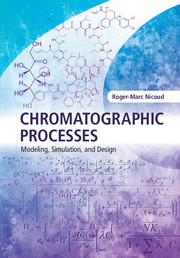Book contents
- Frontmatter
- Contents
- Preface and acknowledgments
- 1 Our approach to modeling chromatographic processes
- 2 Linear chromatography: the Russian Lego
- 3 Non-linear chromatography: equilibrium theory
- 4 Fluid–solid phase equilibria
- 5 Mass transfer
- 6 Hydrodynamics of chromatographic columns
- 7 Simulating chromatographic columns
- 8 Counter-current systems
- 9 Chromatographic modes and their optimization
- 10 Addressing a few industrial problems
- 11 Conclusion
- Appendix A Some important properties of the Laplace transform
- Appendix B Inlet and outlet boundary conditions
- Appendix C Equilibrium theory: single-solute chromatograms
- Appendix D Equilibrium theory: binary chromatograms
- Appendix E The influence of the porosity determination on chromatographic modeling
- Appendix F Useful physico-chemical data and orders of magnitude
- Appendix G Fick and Maxwell–Stefan approaches to diffusion
- Appendix H Non-linear LDF for multi-solute systems
- Appendix I Situations that make the use of the MC model problematic
- Appendix J Typical industrial chromatographic processes
- Notation
- Index
11 - Conclusion
Published online by Cambridge University Press: 05 April 2015
- Frontmatter
- Contents
- Preface and acknowledgments
- 1 Our approach to modeling chromatographic processes
- 2 Linear chromatography: the Russian Lego
- 3 Non-linear chromatography: equilibrium theory
- 4 Fluid–solid phase equilibria
- 5 Mass transfer
- 6 Hydrodynamics of chromatographic columns
- 7 Simulating chromatographic columns
- 8 Counter-current systems
- 9 Chromatographic modes and their optimization
- 10 Addressing a few industrial problems
- 11 Conclusion
- Appendix A Some important properties of the Laplace transform
- Appendix B Inlet and outlet boundary conditions
- Appendix C Equilibrium theory: single-solute chromatograms
- Appendix D Equilibrium theory: binary chromatograms
- Appendix E The influence of the porosity determination on chromatographic modeling
- Appendix F Useful physico-chemical data and orders of magnitude
- Appendix G Fick and Maxwell–Stefan approaches to diffusion
- Appendix H Non-linear LDF for multi-solute systems
- Appendix I Situations that make the use of the MC model problematic
- Appendix J Typical industrial chromatographic processes
- Notation
- Index
Summary
Let us end the journey…
Starting with relatively basic definitions and a description of ideal chromatographic systems, we have explored thermodynamics, hydrodynamics and mass transfer to illustrate different models of chromatography. Similarly, we have explored different techniques, from transfer functions to methods of characteristics, from numerical methods for solving ODEs to optimization algorithms for simulating chromatographic processes. All these models and techniques have then been linked in order to explore systems design. Modeling, simulating and designing chromatographic processes require many ingredients that must be combined in due proportions, according to the problem to be solved.
Modeling is neither a simple fitting of experimental results nor the use of statistics for representing data without physical knowledge. It should be a tool, allowing us to identify dominant mechanisms and predict behaviors in unexplored regions, a way to investigate, to think, to improve, to gain knowledge and understanding, and finally to stimulate creativity.
It is amazing that chromatography has for so long avoided one of the main factors of progress of the 20th century. Today, when a new airplane is developed, it is numerically designed, taking into account constraints such as the desired number of passengers, range, speed, fuel consumption, noise and so on, and based on this numerical design, it is built and it flies. This example is certainly simplified, but the test pilots of today are much safer than their ancestors were, when planes were designed by pure trial and error.
At the beginning of the 21st century, many chromatographic processes are still developed by trial-and-error methodologies like those used by the pioneers of aviation. I see no reason in principle (but many practical difficulties) why science cannot produce greater and greater numerical tools for simulating (and stimulating …) chromatographic processes.
The modeling of chromatographic processes is neither as difficult as it may seem to many practitioners nor as well understood and ready to use as modeling specialists may dream. Let us conclude with three key messages.
- Type
- Chapter
- Information
- Chromatographic ProcessesModeling, Simulation, and Design, pp. 604 - 605Publisher: Cambridge University PressPrint publication year: 2015

